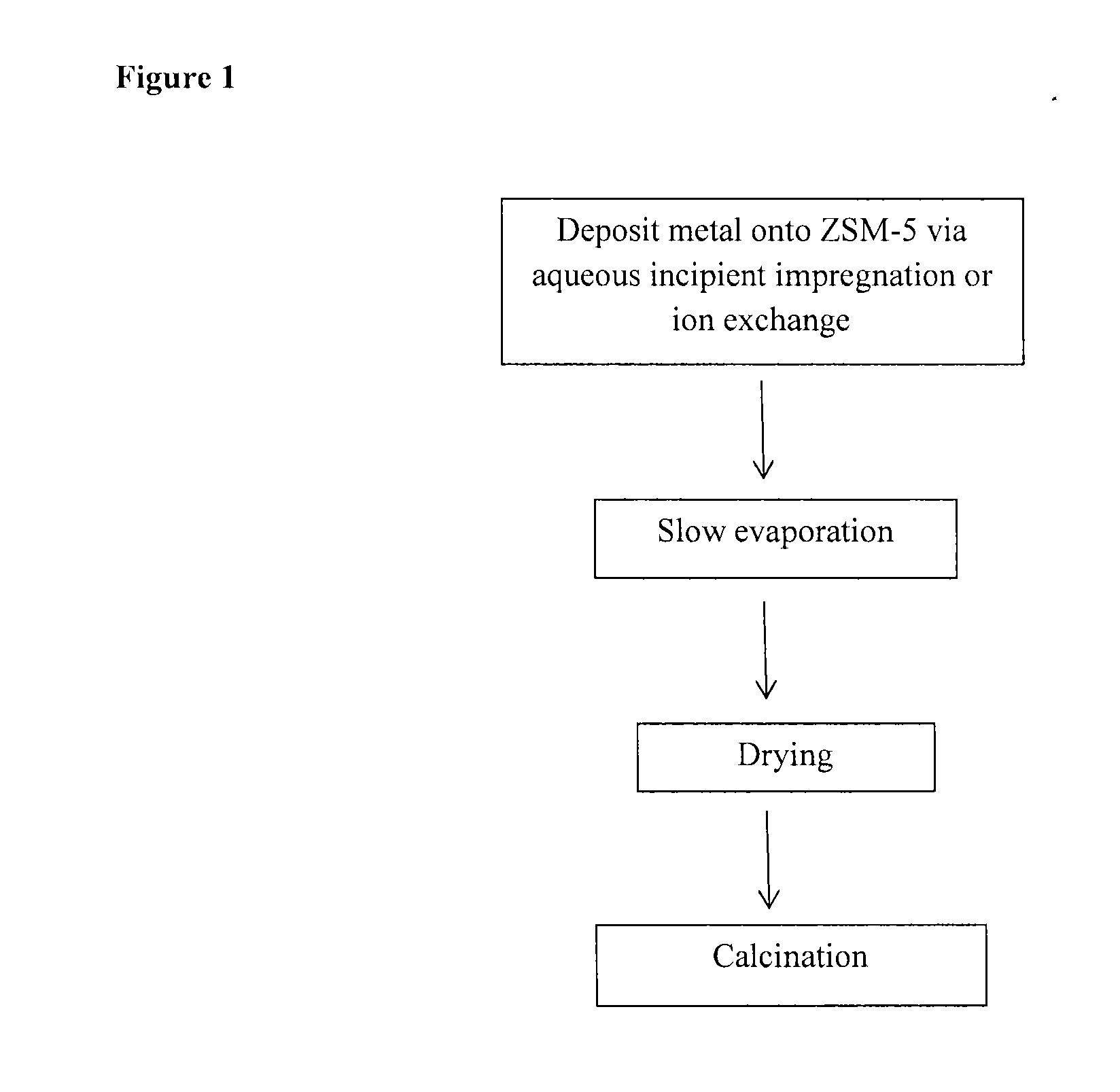Metal-modified zeolite for catalytic cracking of heavy oils and process for producing light olefins
a technology of heavy oil and catalytic cracking, which is applied in the field of metal-modified zeolite for catalytic cracking of heavy oil and process for producing light olefins, and metal-modified zeolite catalyst additives, to achieve the effect of increasing the propylene yield and less expense of gasoline yield
- Summary
- Abstract
- Description
- Claims
- Application Information
AI Technical Summary
Benefits of technology
Problems solved by technology
Method used
Image
Examples
example 1
[0042]1.0 g of HZSM-5 (from Zeolyst) with a Si / Al molar ratio=30 was stirred in 10 ml aqueous solution containing 0.10 g of manganese salt precursor (manganese (II) nitrate hexahydrate) that corresponded to a Mn loading of 2.0 wt %. The mixture was stirred for 3 h and then the solvent was removed by slow evaporation at 60° C. in a drying oven. The product was dried at 100° C. overnight and then calcined at 550° C. at a heating rate of 3° C. / min with holding time of 5 h thereby forming additive A. The same procedure was repeated to form additive B by using 0.20 g of manganese (II) nitrate hexahydrate that corresponded to a Mn loading of 4.0 wt %. The MAT performance results at constant conversion (70%) for VGO cracking over the base E-Cat, E-Cat / unmodified ZSM-5(30), and E-Cat / additives (A and B) are presented in Table 2.
TABLE 2E-Cat / 25% AdditiveE-CatZSM-5(30)Additive AAdditive BMn loading, wt %002.04.0Catalyst / oil ratio, g / g1.72.51.71.8Product yield, %Dry Gas3.25.84.64.7H20.050.20.0...
example 2
[0043]The procedure of Example 1 was repeated by using HZSM-5 (from Zeolyst) with a Si / Al ratio=80 to form additives C and D with 2.0 wt % and 4.0 wt % Mn loadings, respectively. The MAT performance results at constant conversion (70%) for VGO cracking over the base E-Cat, E-Cat / unmodified ZSM-5(80), and E-Cat / additives (C and D) are presented in Table 3.
TABLE 3E-Cat / 25% AdditiveE-CatZSM-5(80)Additive CAdditive DMn loading, wt %002.04.0Catalyst / oil ratio, g / g1.71.82.32.0Product yield, %Dry Gas3.25.15.44.4H20.050.070.10.08C10.70.80.90.8C2═1.43.23.32.5C20.81.01.00.9LPG15.931.433.329.2C3═5.010.713.111.4C30.63.82.351.6C4═7.410.612.611.9n-C40.41.71.20.8i-C42.14.84.23.4C2═-C4═13.824.529.025.9Gasoline50.033.430.836.0LCO12.811.210.811.3HCO17.219.019.118.4Coke0.50.80.80.7C3═ / Gasoline aBase6.98.49.1a percent increase in propylene yield per unit decrease in gasoline yield
example 3
[0044]The procedure of Example 1 was repeated by using HZSM-5 (from Zeolyst) with a Si / Al ratio=280 to form additives E and F with 2.0 wt % and 4.0 wt % Mn loadings, respectively. The MAT performance results at constant conversion (70%) for VGO cracking over the base E-Cat, E-Cat / unmodified ZSM-5(280), and E-Cat / additives (E and F) are presented in Table 4.
TABLE 4E-Cat / 25% AdditiveE-CatZSM-5(280)Additive EAdditive FMn loading, wt %002.04.0Catalyst / oil ratio, g / g1.72.32.01.8Product yield, %Dry Gas3.24.64.03.7H20.050.060.060.06C10.70.80.80.7C2═1.42.82.32.0C20.80.90.90.8LPG15.929.831.128.9C3═5.011.712.611.6C30.61.91.41.2C4═7.4011.513.112.4n-C40.40.90.70.7i-C42.13.93.33.0C2═-C4═13.825.926.026.0Gasoline50.035.037.137.1LCO12.811.412.112.1HCO17.218.617.917.9Coke0.50.60.50.5C3═ / Gasoline aBase8.911.810.2a percent increase in propylene yield per unit decrease in gasoline yield
[0045]The MAT results of Examples 1 to 3 show the advantages of the addition of Mn-modified ZSM-5 zeolites to the FCC ...
PUM
| Property | Measurement | Unit |
|---|---|---|
| molar ratio | aaaaa | aaaaa |
| cracking temperature | aaaaa | aaaaa |
| particle size distribution | aaaaa | aaaaa |
Abstract
Description
Claims
Application Information
 Login to View More
Login to View More - R&D
- Intellectual Property
- Life Sciences
- Materials
- Tech Scout
- Unparalleled Data Quality
- Higher Quality Content
- 60% Fewer Hallucinations
Browse by: Latest US Patents, China's latest patents, Technical Efficacy Thesaurus, Application Domain, Technology Topic, Popular Technical Reports.
© 2025 PatSnap. All rights reserved.Legal|Privacy policy|Modern Slavery Act Transparency Statement|Sitemap|About US| Contact US: help@patsnap.com

